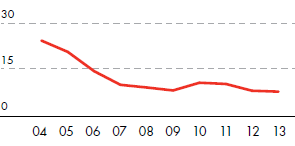Flaring – Upstreammillion tonnes CO2 equivalent

The flaring of natural gas in our Upstream business decreased in 2013 to 7.4 million tonnes of CO2 equivalent, from 7.7 million tonnes of CO2 equivalent in 2012. The decrease was mainly due to lower flaring in Nigeria in line with lower production as well as completion of start-up activities at the Pearl GTL plant in Qatar, partially offset by the restart of production at Majnoon in Iraq.
Our HSSE & SP Control Framework requires our new facilities to be designed so as not to flare or vent (releasing gas to the atmosphere) continuously. When we acquire or become the operator of an existing facility that is already flaring or venting, it takes time before these activities can be stopped.
Overall, flaring made up around 10% of the total direct GHG emissions in 2013. Nigeria and Iraq accounted for around 50% and 10% of this flaring in 2013, respectively, with the remainder mainly from the Pearl GTL plant in Qatar and operations in the UK and Malaysia. In 2013, we further reduced the flaring intensity – hydrocarbons flared per tonne of production – to the lowest level we have recorded for our Upstream business.
Operational flaring occurs for safety reasons, or during the start-up of Upstream facilities. We aim to minimise this operational flaring.
Continuous flaring takes place due to a lack of equipment to capture the gas produced with oil. Most of the continuous flaring in 2013 took place in Nigeria and Iraq. Flaring from the Majnoon field in Iraq will continue to rise in future years as production increases. We are currently working with partners on plans to capture the associated gas.
Outside Nigeria and Iraq, the few facilities that continuously flare accounted for less than 1% of our total direct GHG emissions in 2013. Some of these facilities are at ageing oil fields where the associated gas pressure is too low to power the compressors used to gather the gas and avoid flaring. In 2013, the venting of hydrocarbons amounted to around 1% of our total direct GHG emissions.
